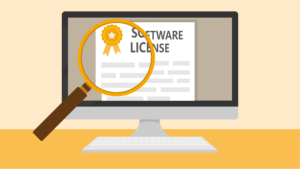In our everyday work, we get confronted with numerous types of software solutions. From simple word processing to complex database management systems and graphic design programs – all these applications enable us to do our work effectively and efficiently. The use of these applications usually requires appropriate licensing. In this article, we will explain how licenses are audited and why license audits are so important.
What is a License Audit?
If violations of the license terms are identified, the consequences can be far reaching. Depending on the severity of the violation, high additional payments may be due. In the worst case, there may even be legal consequences such as fines or claims for compensation by the software manufacturer. It is therefore important to know the respective license conditions precisely and to comply with them in order to avoid unpleasant surprises and possible financial or legal consequences. This also emerges from a circular issued by RWTH Aachen University (available on the RWTH intranet) on the subject of software licensing.
License audits aim to ensure that companies do not inadvertently violate license agreements. In addition, license audits can also help avoid unnecessary costs by ensuring that companies only use the licenses they actually need. Unused licenses can be identified in this way and resold if necessary.
How Does a License Audit Work?
License audits are usually performed by the software manufacturers themselves or by external license experts. The conduct of the audit can vary depending on the scope and complexity of the software solutions. In this process, the company is informed by the manufacturer or licensor in a cover letter stating that the legally compliant use of their products is to be audited. At RWTH Aachen University, there is a specific recommendation for action that explains in detail how to deal with such requests. This recommendation for action can be accessed via the RWTH Aachen intranet.
Once the general procedure for the audit and other important formalities, such as questions about data protection and confidentiality agreements, have been clarified, the actual audit begins. During this process, the license agreements and terms and conditions are checked. Next, the installations of the individual software solutions on the computers are checked and the usage history is recorded. The data collected is used to determine whether the company has all the required licenses and whether they are being used properly.
In a final meeting, the results are presented, and the auditor can make recommendations for remedying problems, if necessary.
How Can a Company Be Prepared for a License Audit?
To avoid unpleasant surprises during a license audit, a company can take various measures. Software asset management (SAM) involves identifying, monitoring, managing and optimizing software licenses and usage in a company. By using SAM tools, companies can keep track of the software they use. As a result, license violations can be avoided. The use of SAM tools at RWTH was also further outlined in a corresponding circular (available on the RWTH intranet).
In addition, regular training and raising employees’ awareness of how to deal with software and the associated licensing conditions can also help to avoid license violations and thus unpleasant consequences such as high additional payments or legal consequences.
If you would like to learn more about licensing, we recommend our article on software licenses. There we explain how software licenses work and what different types of licenses there are.
Responsible for the content of this article is Stéphanie Bauens.





